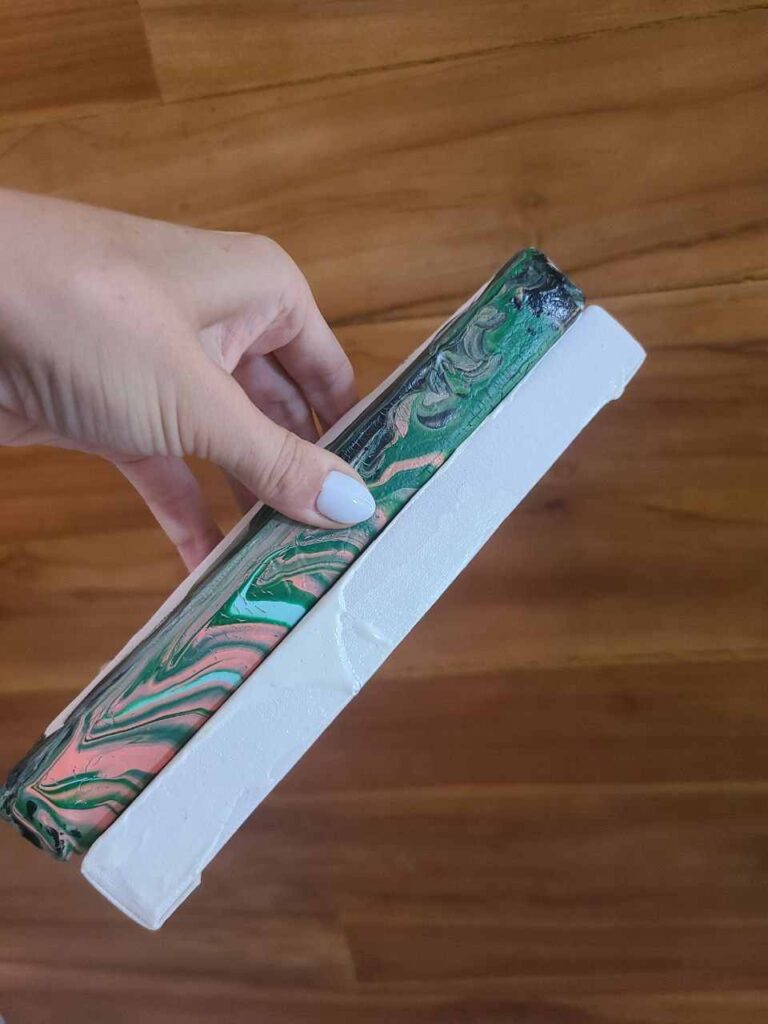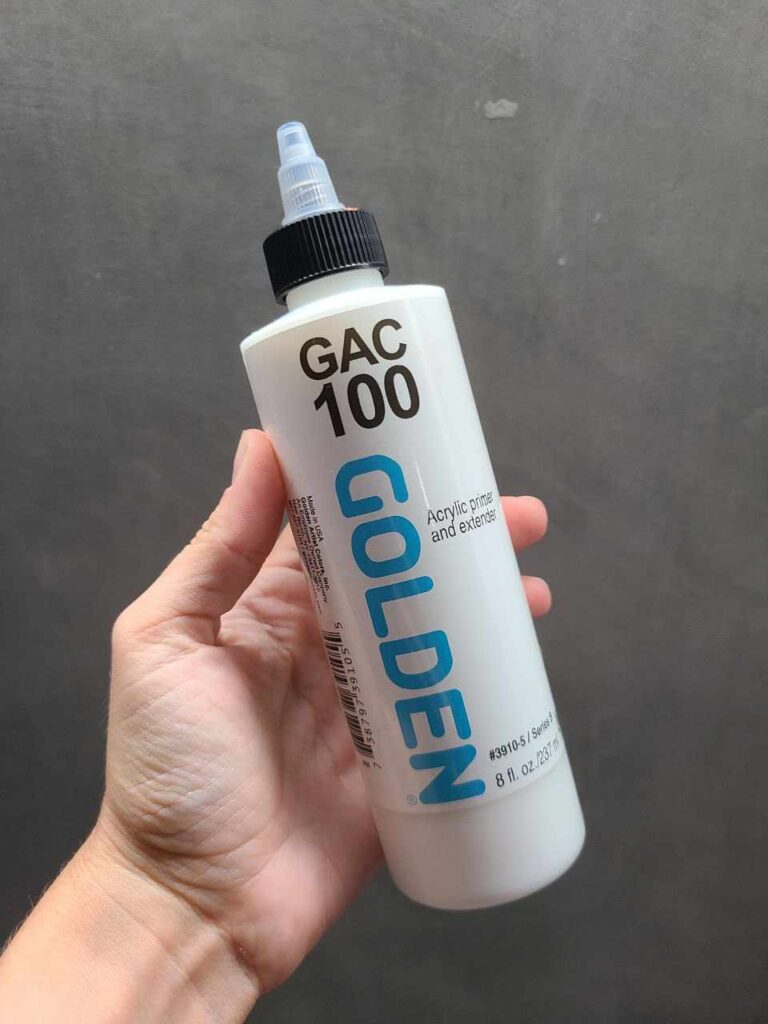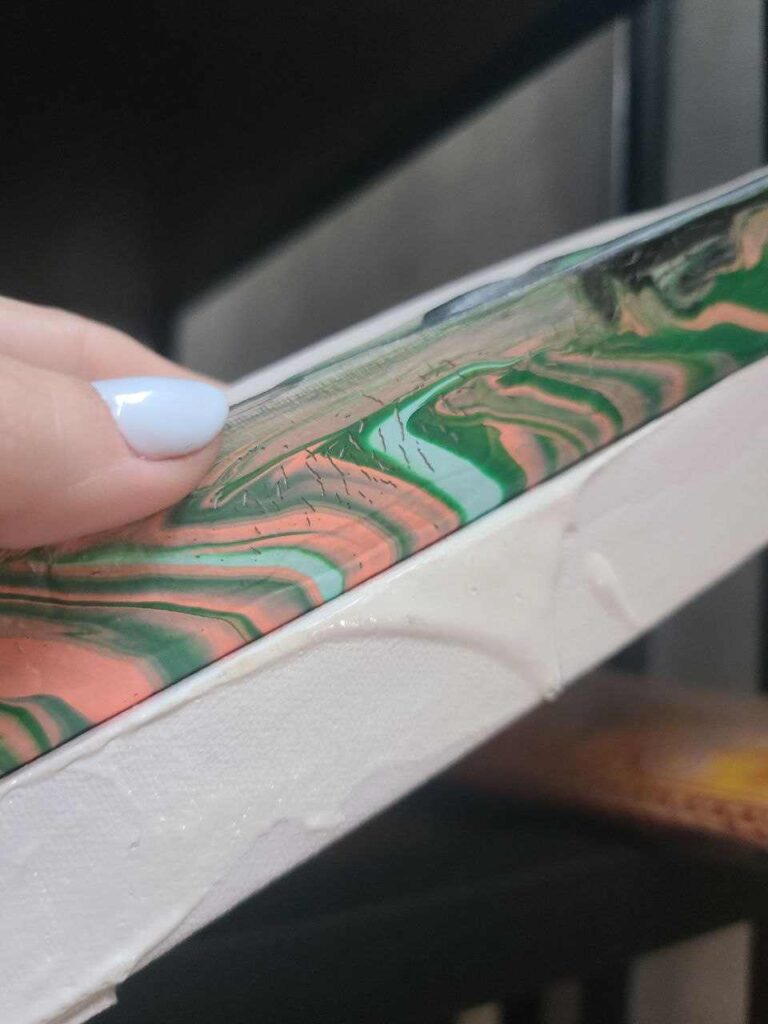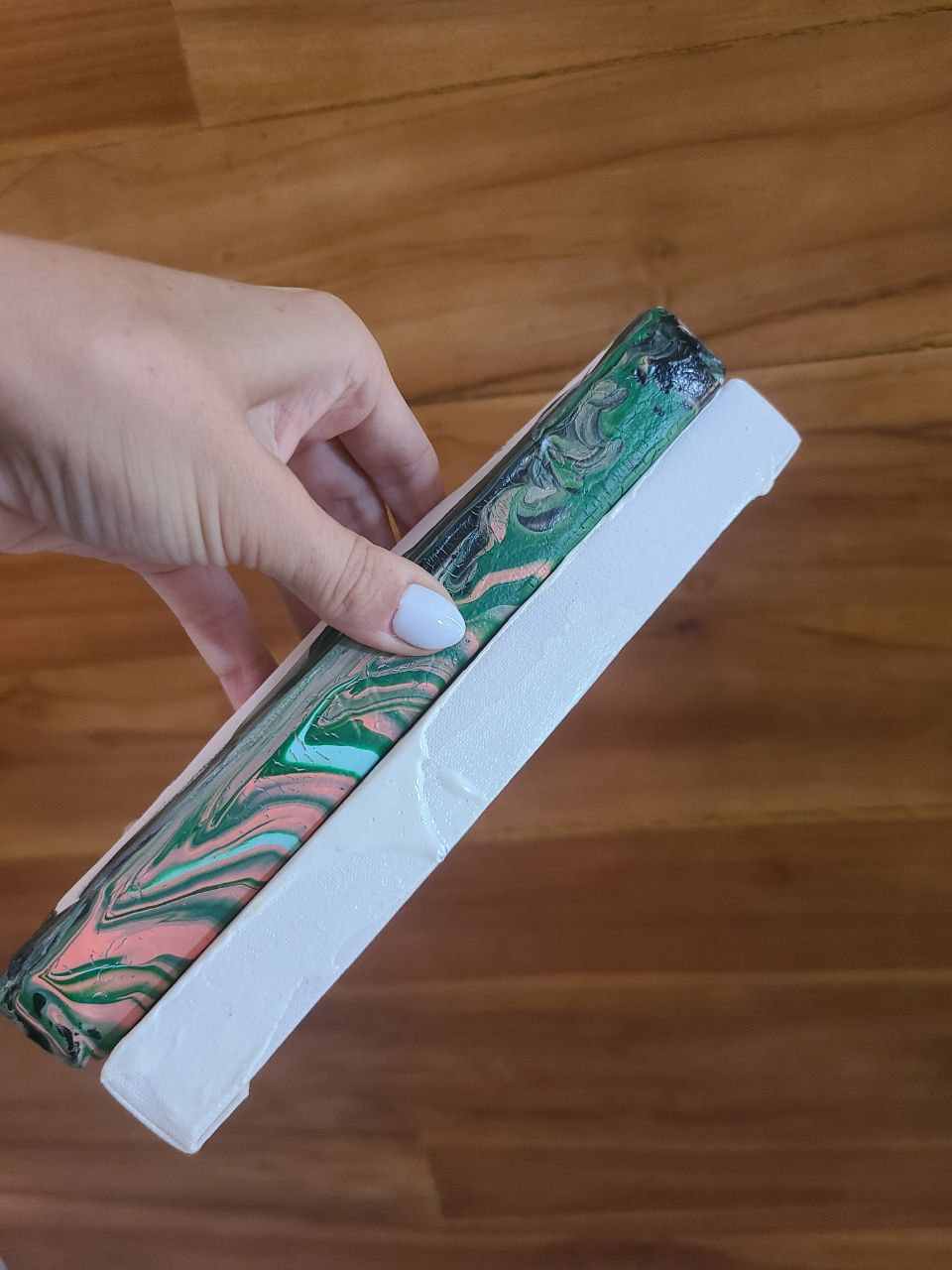Last Updated on March 19, 2024 by Masha Eretnova
Sticky or tacky acrylic paintings can be frustrating. Have you ever stored two paintings face to face and then struggled to separate them?
But don’t worry, there is probably nothing wrong with your paint and there are ways how to fix sticky acrylic paint!
Your acrylic can be still wet underneath so to fix sticky acrylics allow it to dry for up to 4 weeks. One of the best ways to fox sticky acrylic paint is to apply 1-3 coats of varnish or sealant over the painting.
But do you know why is your acrylic paint sticky? Probably because of its nature and drying conditions. I will talk about it in details below.
If acrylic paintings are sticky when you store them, place parchment or wax paper between the paintings to prevent them from sticking together.
Table of Contents
This article contains affiliate links. It means no extra cost for you but a little commission (2-3%) for me to support my hobby and blog. Thank you!

why is Your acrylic paint sticky after drying?
When it comes to acrylic paint, tackiness can be a sticky situation. Sticky paint collects dust and dirt much easier and challenging to store.
Acrylic paint rarely stays sticky when dry as it dries really fast and the main reason of sticky paint is slow drying. Yet, it is absolutely normal for to unvarnished acrylic paintings stacked together to skick over time.
Always test how tacky the paint is with the back of your knuckle and not with your fingers (to avoid leaving finger prints).
Acrylic paint can stay sticky and tacky after drying due to high humidity, low temps, use of slow-drying paint, short drying time or a heavy hand with the brush and thick layers.
To fix paint stickiness warm up your space, bust out the hairdryer, or simply be patient and give your masterpiece some extra drying time.
Here are 12 possible reasons why acrylic paint may remain sticky after drying:
- Applying the paint too thickly: If the paint is applied too thickly, it may take longer to dry and can remain sticky. Even if you feel the top layer dry to touch, underlying layers can still be wet.
- Using poor quality paintor mixing different brands: Low-quality paint may contain fillers and enhancers as well as low-quality binders and pigments, which can cause the paint to remain sticky after drying.
- Using too much water: Adding too much water to the paint can cause it to become too thin and take longer to dry, resulting in a sticky surface.
- Using the wrong type of surface: Some surfaces, such as glossy or non-porous surfaces, may not allow the paint to adhere properly, causing it to remain sticky.
- High humidity: High humidity can slow down the drying process and cause the paint to be sticky.
- Using old or expired paint: Old or expired paint may not dry properly or start separating in the tube and can remain tacky once dry.
- Using too much medium: Adding too much medium to the paint can cause it to become too thin and take longer to dry.
- Using too much retarder: Retarder is a medium that slows down the drying process.
- Insufficient ventilation: A lack of ventilation can also slow the drying time.
- Simply Not allowing enough drying time: Acrylic paint can take up to 24 hours to dry completely but thick layers, unstable temperatures and humidity or some DIY mixed in mediums can extend this time. Allow a full week or a full month and see what happens.
- You mixed acrylic paint with epoxy. Epoxy is tricky to dry and id there was any slight change in ratio or drying conditions it won’t dry completely and will stay tacky.
- Unvarnished painting surface. Finished but unvarnished acrylic paintings can stick to each other if simply stacked one on top of each other.
To prevent acrylic paint from remaining sticky after drying, it is important to use high-quality paint, apply it thinly, and ensure that the surface and workspace are suitable for acrylic painting.
Read also: How to make acrylics dry slower.

Humidity increases acrylic paints’ stickiness
Humidity can cause acrylic paint to dry sticky because it slows down the evaporation of water in the paint.
Acrylic paint dries by water evaporating from the paint film, leaving behind a solid layer of pigment and binder.
However, when the air is humid, the water in the paint may not evaporate properly, causing the paint to remain tacky or sticky even after the surface appears dry.
This can also lead to the formation of a skin on the surface of the paint film, which can trap moisture underneath and cause the paint to remain sticky.
Fix: The optimal humidity for acrylic paint to dry properly is between 40% and 60%. Open windows, or use a dehumidifier to reduce the moisture in the air.
Low temperature increases tackiness
The optimal temperature for acrylic paint to dry properly is between 65°F (18°C) and 75°F (24°C).
If the temperature is too low, the paint may dry too slowly or not at all, causing it to remain tacky or sticky.
Extremely low temperatures at the same time can completely freeze the paint.
Fix: use a heater, AC, a hairdryer or move your acrylic painting to a warmer room to speed up the drying process.
Read also: Is Paint Flammable or Combustible? Acrylic, Oil, Latex and Mediums Explained
Not giving the paint enough time to dry
Not giving the paint enough time to dry can result in sticky paint because the surface may appear dry, but the underlying layers of paint may still be wet.
Even though acrylic paint is fast-drying (30 min), the time it needs to cure fully is minimum 24 hrs or weeks (up to 1 month).
When a new layer of paint is applied over a layer that is not yet dry, the polymers in the new layer can reactivate the polymers in the underlying layer, causing the paint to become tacky or sticky.
This can also happen when the paint is applied too thickly, as the surface may dry quickly while the underlying layers remain wet and the moisture is trapped.
Fix: read the label and ask the brand on recommended drying time, wait at least 1week to test the sticky paint.
Using different acrylic mediums may lead to sticky paint
Glazing mediums, extenders, slow-drying mediums, gels and pastes can slow down the drying time of acrylic paint.
Some mediums, such as flow improvers, can help to improve the flow and leveling of the paint, making it easier to apply and reducing the likelihood of it becoming sticky.

Other mediums, such as retarders, can slow down the drying process, which can increase the risk of the paint becoming sticky if not used properly.
Using too much medium, or the wrong type of medium, can also affect the drying time and consistency of the paint, which can lead to a sticky finish.
Fix: follow the manufacturer’s instructions when using acrylic mediums, and to test any new mediums on a small area of the painting before using them on a larger scale. Don’t add more than 20% of water if using mediums or no water at all.
Using slow-drying acrylic paint
Slow-drying acrylics may take hours to even dry to touch and weeks to fully cure.
You may be too impatient to see them drying but it is ok for them to feel wet or sticky within first week or so.
Contact the brand to make sure you waited long enough.
Store a painting made using slow-drying paints in a way that it doesn’t touch anything around it. You can place a plastic container with some ventilation over it.
Painting surface
Some surfaces, such as glossy or non-porous surfaces, may not allow the paint to adhere properly, causing it to remain sticky, peel off or not adhere at all.
In addition, using a surface that is too absorbent, such as raw canvas or unprimed wood, can cause the paint to soak into the surface and become dull.
Using a surface that is too rough or textured can also cause the paint to become sticky, as the uneven surface can cause the paint to dry unevenly.
Fix: use a surface that is appropriate for acrylic painting, such as a primed canvas, gessoed board, or paper designed for acrylics.
Read also: How to Prime Wood for Acrylic Painting
Thick layers
A thick layer of acrylic paint can make it sticky because the outer layer of the paint film may dry quickly, forming a skin or crust, while the underlying layers remain wet.
When the underlying layers of paint eventually dry, they can adhere to the skin on the surface, causing the paint to become tacky or sticky or even crack.
In addition, applying thick layers of paint can also increase the amount of moisture in the paint, which can affect the drying time and cause the paint to remain tacky or sticky longer than you expected.
Fix: paint in thin layers allowing each one to dry. If thick layers are needed for your style, use textured gels to increase volume instead of thick paint layer, and wait longer for it to dry.

How to fix sticky acrylic paint?
If your acrylic paint has become sticky after drying, there are a few things you can try to fix it:
- Apply a varnish or sealant: Applying a thin layer of varnish or acrylic medium over the surface can help to seal the paint and prevent further stickiness.
- Increase air circulation: Increasing air circulation in the workspace by using a fan or opening windows can help to speed up the drying process and prevent stickiness.
- Use a dehumidifier: If the humidity is high, using a dehumidifier can help to reduce moisture in the air and speed up the drying process.
- Heat fix if it is too cold: Using a hairdryer or heat gun on a low setting can help to speed up the drying process and prevent stickiness. Or simply move your painting to a warmer room.
- Sand the surface: If the paint is still sticky, you can try sanding the surface lightly with fine-grit sandpaper to remove the sticky layer and create a smooth surface, and reapply paint or varnish.
- If you used acrylic paint mixed with epoxy to fix tackiness, apply another thin layer of clear epoxy with no paint in it. The new layer should dry properly.
- If acrylic paintings stick to each other when stored, use a divider like a parchment paper or wax, a wooden storage with spacers or varnish them.
- Switch to matte mediums – they tend to be a lot less sticky.
- Dust sticky areas of your acrylic painting with a fine powder like a pigment, or translucent powder (makeup), eye shadow, cornstarch or rice starch (some people even use talcum powder but I wouldn’t), or a metallic powder. It will stop sticking!
- If the paint sticks to your skin or palette, simply wash it with warm water and soap. If the paint has hardened already, you may need to scrub it.
It’s important to note that these methods may not work for all cases of sticky acrylic paint, and it’s always best to test them on a small, inconspicuous area first.
Read also: How To Remove Acrylic Paint Easily? Full Guide (Skin, Fabric, Floor, Wood, etc)
What I do to make my acrylic paintings non-sticky
- I monitor temp and humidity in my studio room – my air purifier has an LED display with those numbers
- I test the paint drying time on paper and/or on canvas before painting
- I test drying time when using mediums
- I store unvarnished paintings with a distance between them, like this:

I repurposed two wooden dish racks to store small acrylic pourings I do.
Instead of Final Words: Personal experience with acrylic paint brands
I believe that most acrylic paints I have ever used are not sticky at all, and are sticky only when they get stacked up together unvarnished and left for a long time like that.
Which is my storing mistake and nothing wrong with the paint.
I haven’t experienced any acrylic paint (and I use it in both thin and thick layers and live in tropical climates) to be sticky to the touch once dry or after varnishing.
How do you tackle the issue?

Masha Eretnova, born in 1991, is a Buenos Aires-based certified teacher, artist, and member of the Professional Artist Association with 20+ years of personal painting journey.
She started painting and drawing very early and is now an international abstract artist and educator passionate about acrylic painting, gouache, and crafts.
Her works are part of international exhibitions and contests, including ArtlyMix (Brazil), Al-Tiba 9 (Spain), Exhibizone (Canada), Italy, and many more.
Besides her artistic pursuits, Masha holds a post-grad diploma in Teaching Film Photography and 2 music school diplomas: piano and opera singing.
